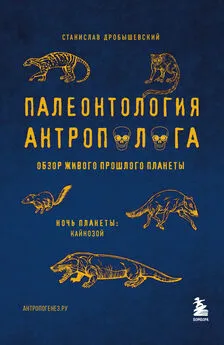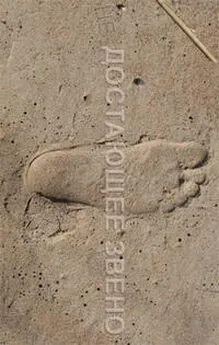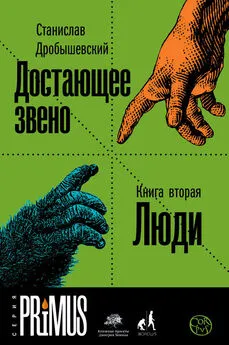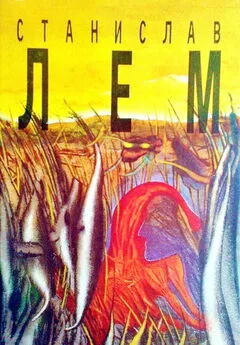Станислав Дробышевский - Палеонтология антрополога. Том 3. Кайнозой
- Название:Палеонтология антрополога. Том 3. Кайнозой
- Автор:
- Жанр:
- Издательство:неизвестно
- Год:2022
- ISBN:978-5-04-162005-9
- Рейтинг:
- Избранное:Добавить в избранное
-
Отзывы:
-
Ваша оценка:
Станислав Дробышевский - Палеонтология антрополога. Том 3. Кайнозой краткое содержание
Палеонтология антрополога. Том 3. Кайнозой - читать онлайн бесплатно ознакомительный отрывок
Интервал:
Закладка:
Rougier G. W., Wible J. R., Beck R. M.D. et Apesteguia S. The Miocene mammal Necrolestes demonstrates the survival of a Mesozoic nontherian lineage into the late Cenozoic of South America // Proceedings of the National Academy of Sciences USA, 2012, V.109, № 49, pp.20053–20058.
Salesa M. J., Peigne S., Anton M. et Morales J. Evolution of the family Ailuridae: origins and old-world fossil record // Red panda biology and conservation of the first panda. Ed.: Glatston A. R. Elsevier, 2011, pp.27–41. Эволюция малых панд.
Sanchez-Villagra M.R., Kay R. F. et Anaya-Daza F. Cranial anatomy and palaeobiology of the Miocene marsupial Hondalagus altiplanensis and a phylogeny of argyrolagids // Palaeontology, 2000, V.43, pp.287–301.
Senut B., Pickford M., Gommery D., Mein P., Cheboi K. et Coppens Y. First hominid from the Miocene (Lukeino Formation, Kenya) // Comptes Rendus de l’Academie des Sciences, Ser.II, fascicule A – Sciences de la Terre et des planetes, 2001, V.332, № 2, pp.137–144. Orrorin tugenensis .
Shi Q. Q. New species of Tsaidamotherium (Bovidae, Artiodactyla) from China sheds new light on the skull morphology and systematics of the genus // Science China Earth Sciences, 2014, V.57, № 2, pp.258–266.
Shoshani J. et Tassy P. Advances in proboscidean taxonomy & classification, anatomy & physiology, and ecology & behavior // Quaternary International, 2005, V.126–128, pp.5–20.
Sonntag Ch.F. et Woollard H. H. A monograph of Orycteropus afer . – II. Nervous system, sense-organs and hairs // Proceedings of the Zoological Society of London, 1925, V.95, № 3, pp.1185–1235. Мозг трубкозуба.
Spassov N., Geraads D., Hristova L., Markov G. N., Merceron G., Tzankov T., Stoyanov K., Bohme M. et Dimitrova A. A hominid tooth from Bulgaria: the last pre-human hominid of continental Europe // Journal of Human Evolution, 2012, V.62, pp.138–145.
Tedford R. H., Barnes L. G. et Ray C. E. The early Miocene littoral ursoid carnivoran Kolponomos : systematics and mode of life // Proceedings of the San Diego Society of Natural History, 1994, № 29, pp.11–32.
Tennyson A. J.D., Worthy T. H., Jones C. M., Scofield R. P. et Hand S. J. Moa’s Ark: Miocene fossils reveal the great antiquity of moa (Aves: Dinornithiformes) in Zealandia // Records of the Australian Museum, 2010, V.62, pp.105–114. Древнейшие моа.
The Proboscidea: evolution and palaeoecology of elephants and their relatives. Eds.: Shoshani J. et Tassy P. Oxford, Oxford University Press, 1996, 472 p.
Tseng Z. J., Wang X., Slater G. J., Takeuchi G. T., Li Q., Liu J. et Xie G. Himalayan fossils of the oldest known pantherine establish ancient origin of big cats // Proceedings of the Royal Society B: Biological Sciences, 2014, V.281, № 20132686, pp.1–7. Panthera blytheae – древнейшая большая кошка из Тибета.
Van der Geer A. A.E. Systematic revision of the family Hoplitomerycidae Leinders, 1984 (Artiodactyla: Cervoidea), with the description of a new genus and four new species // Zootaxa, 2014, V.3847, № 1, pp.1–32.
Van der Geer A. A.E. The effect of insularity on the Eastern Mediterranean early cervoid Hoplitomeryx : the study of the forelimb // Quaternary International, 2008, V.182, pp.145–159.
Villarroel A. C. et Marshall L. G. A new argyrolagoid (Mammalia: Marsupialia) from the middle Miocene of Bolivia // Journal of Paleontology, 1988, V.62, № 3, pp.463–467. Сумчатый “тушканчик” Hondalagus altiplanensis .
Wible J. R. et Rougier G. W. Craniomandibular anatomy of the subterranean meridiolestidan Necrolestes patagonensis Ameghino, 1891 (Mammalia, Cladotheria) from the Early Miocene of Patagonia // Annals of Carnegie Museum, 2017, V.84, № 3, pp.183–252.
Worthy T. H., Tennyson A. J.D., Archer M., Musser A. M., Hand S. J., Jones C., Douglas B. J., McNamara J.A. et Beck R. M.D. Miocene mammal reveals a Mesozoic ghost lineage on insular New Zealand, southwest Pacific // Proceedings of the National Academy of Sciences USA, 2006, V.103, № 51, pp.19419–19423. Млекопитающие Новой Зеландии.
Worthy T. H., Tennyson A. J.D., Jones C., McNamara J.A. et Douglas B. J. Miocene waterfowl and other birds from Central Otago, New Zealand // Journal of Systematic Palaeontology, 2007, V.5, pp.1–39. Древнейшие моа.
Worthy T. H., Worthy J. P., Tennyson A. J.D., Salisbury S. W., Hand S. J. et Scofield R. P. Miocene fossils show that kiwi (Apteryx, Apterygidae) are probably not phyletic dwarves // Paleornithological Research 2013, Proceedings of the 8th International Meeting of the Society of Avian Paleontology and Evolution, 2013, pp.63–80. Киви Proapteryx micromeros .
Симпсон Дж. Великолепная изоляция. История млекопитающих Южной Америки. М., Мир, 1983, 256 с.
Amson E., Argot Ch., McDonald H.G. et Muizon de Ch. Osteology and functional morphology of the axial postcranium of the marine sloth Thalassocnus (Mammalia, Tardigrada) with paleobiological implications // Journal of Mammalian Evolution, 2015, pp.1–46.
Bobe R., Manthi F. K., Ward C. V., Plavcan J. M. et Carvalho S. The ecology of Australopithecus anamensis in the early Pliocene of Kanapoi, Kenya // Journal of Human Evolution, 2020, pp.1–19.
Braun D. R., Aldeias V., Archer W., Arrowsmith J. R., Baraki N., Campisano Ch.J., Deino A. L., DiMaggio E.N., Dupont-Nivet G., Engda B., Feary D. A., Garello D. I., Kerfelew Z., McPherron Sh.P., Patterson D. B., Reeves J. S., Thompson J. C. et Reed K. E. Earliest known Oldowan artifacts at >2.58 Ma from Ledi-Geraru, Ethiopia, highlight early technological diversity // Proceedings of the National Academy of Sciences USA, 2019, V.116, № 24, pp.11712–11717
Dart R. The waterworn Australopithecine pebble of many faces from Makapansgat // South African Journal of Science, 1974, V.70, pp.167–169. Галька-манупорт из Макапансгата.
Downhower J. F. et Blumer L. S. Calculating just how small a whale can be // Nature, 1988, V.335, p.675. Минимальные размеры тела морских теплокровных животных.
Ge D., Wen Zh., Xia L., Zhang Zh., Erbajeva M., Huang Ch. et Yang Q. Evolutionary history of lagomorphs in response to global environmental change // PLOS ONE, 2013, V.8, № 4, № e59668, pp.1–15. Эволюция зайцев.
Kohler M. et Moya-Sola S. Physiological and life history strategies of a fossil large mammal in a resource-limited environment // Proceedings of the National Academy of Sciences USA, 2009, V.106, № 48, pp.20354–20358. Холоднокровность козла Myotragus .
Millien V. The largest among the smallest: the body mass of the giant rodent Josephoartigasia monesi // Proceedings of the Royal Society B: Biological Sciences, 2008, V.275, pp.1953–1955.
Muizon de Ch. et Domning D. P. The anatomy of Odobenocetops (Delphinoidea, Mammalia), the walrus-like dolphin from the Pliocene of Peru and its palaeobiological implications // Zoological Journal of the Linnean Society, 2002, V.134, pp.423–452. Кит Odobenocetops leptodon .
Muizon de Ch. et McDonald H. G. An aquatic sloth from the Pliocene of Peru // Nature, 1995, V.375, pp.224–227.
Muizon de Ch., Domning D. P. et Ketten D. R. Odobenocetops peruvianus , the walrus-convergent delphinoid (Mammalia: Cetacea) from the Early Pliocene of Peru // Smithsonian Contributions to Paleobiology, 2002, V.93, pp.223–261.
Pimiento C., Griffin J. N., Clements Ch.F., Silvestro D., Varela S., Uhen M. D. et Jaramillo C. The Pliocene marine megafauna extinction and its impact on functional diversity // Nature Ecology and Evolution, 2017, V.1, № 8, pp.1100–1106.
Quintana J., Kohler M. et Moya-Sola S. Nuralagus rex , gen. et sp. nov., an endemic insular giant rabbit from the Neogene of Minorca (Balearic Islands, Spain) // Journal of Vertebrate Paleontology, 2011, V.31, № 2, pp.231–240.
Racicot R. A., Demere T. A., Beatty B. L. et Boessenecker R. W. Unique feeding morphology in a new prognathous extinct porpoise from the Pliocene of California // Current Biology, 2014, V.24, pp.774–779. Кит Semirostrum ceruttii .
Reyes de los M., Poire D., Soibelzon L., Zurita A. E. et Arrouy M. J. First evidence of scavenging of a glyptodont (Mammalia, Glyptodontidae) from the Pliocene of the Pampean region (Argentina): taphonomic and paleoecological remarks // Palaeontologia Electronica, 2013, V.16, № 15A, pp.1–13.
Rinderknecht A. et Blanco R. E. The largest fossil rodent // Proceedings of the Royal Society B: Biological Sciences, 2008, V.275, pp.923–928. Гигантский грызун Josephoartigasia monesi .
Saint-Andre P.A. et Iuliis de G. The smallest and most ancient representative of the genus Megatherium Cuvier, 1796 (Xenarthra, Tardigrada, Megatheriidae), from the Pliocene of the Bolivian Altiplano // Geodiversitas, 2001, V.23, № 4, pp.625–645.
Simpson G. G. The Argyrolagidae, extinct South American marsupials // Bulletin of the Museum of Comparative Zoology, 1970, V.139, № 1, pp.1–86.
Villmoare B., Kimbel W. H., Seyoum Ch., Campisano Ch.J., DiMaggio E., Rowan J., Braun D. R., Arrowsmith J. R. et Reed K. E. Early Homo at 2.8 Ma from Ledi-Geraru, Afar, Ethiopia // Science, 2015, V.347, № 6228, pp.1352–1355.
Vizcaino S. F. et De Iuliis G. Evidence for advanced carnivory in fossil armadillos (Mammalia: Xenarthra: Dasypodidae) // Paleobiology, 2003, V.29, № 1, pp.123–138. Хищный броненосец Macroeuphractus outesi .
WoldeGabriel G., White T., Suwa G., Renne P., Heinzelin J. de, Hart W. et Heiken G. Ecological and temporal placement of early Pliocene hominids at Aramis, Ethiopia // Nature, 1994, V.371, pp.330–333. Реконструкция экосистемы Арамиса.
Мащенко Е. Н. Эволюция мамонтоидных слонов на Северном Кавказе (Россия) в плиоцене и плейстоцене // Труды Зоологического института РАН, 2010, Т. 314, № 2, cс.197–210.
Adams D. B. The cheetah: native American // Science, 1979, V.205, pp.1155–1158. Miracinonyx inexpectatus .
Agenbroad L. D. Mammuthus exilis from the California Channel Islands: height, mass, and geologic age // Proceedings of 15 the 7th California Islands Symposium. Eds.: Damiani C. C. et Garcelon D. K. Institute for Wildlife Studies, Arcata, 2009, pp.15–19.
Ambrose S. H. Late Pleistocene human population bottlenecks, volcanic winter, and differentiation of modern humans // Journal of Human Evolution, 1998, V.34, pp.623–651. Извержение вулкана Тоба.
American megafaunal extinctions at the end of the Pleistocene. Ed.: Haynes G. Springer Science + Business Media B. V., 2009, 201 p.
Biknevicius A. R., McFarlane D.A. et MacPhee R.D.E. Body size in Amblyrhiza inundata (Rodentia, Caviomorpha), an extinct megafaunal rodent from the Anguilla Bank, West Indies: estimates and implications // American Museum Novitates, 1993, V.3079, pp.1–25.
Bocherens H., Schrenk F., Chaimanee Ya., Kullmer O., Morike D., Pushkina D. et Jaeger J. – J. Flexibility of diet and habitat in Pleistocene South Asian mammals: implications for the fate of the giant fossil ape Gigantopithecus // Quaternary International, 2017, V.434, pp.148–155.
Читать дальшеИнтервал:
Закладка:





![Станислав Дробышевский - Палеонтология антрополога. Книга 1. Докембрий и палеозой [litres]](/books/1073953/stanislav-drobyshevskij-paleontologiya-antropologa.webp)




